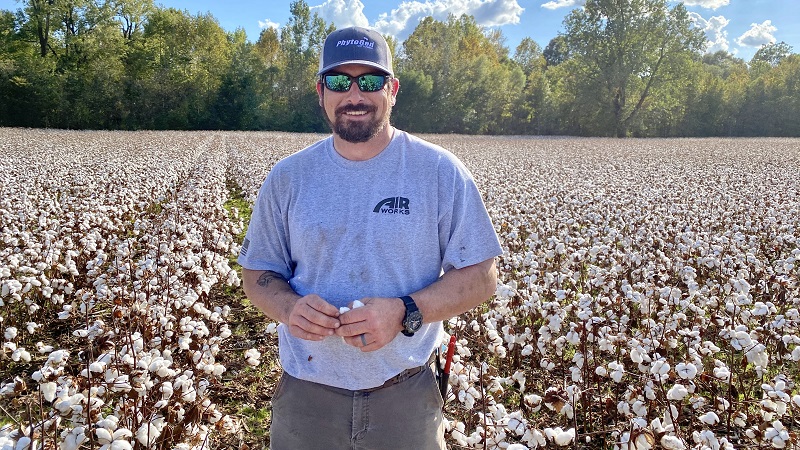Cotton and Soybean Producers Find a Smart Solution to a Shared Enemy

Tennessee producer Dustin Manning plants PhytoGen® W3FE varieties and Pioneer® brand Enlist E3® soybeans for a “seamless flowˮ in weed management from cotton to soybeans.
Despite the differences in terrain between the Arkansas Delta and the terraced hills of west Tennessee, farmers share a common enemy in glyphosate-resistant pigweed.
Cotton producers Nathan B. Reed and Dustin Manning also share a common solution — one that works for both cotton and soybean acres.
“I chose to go with PhytoGen cottonseed and Pioneer brand Enlist E3 soybeans to use the Enlist weed control system in both crops,ˮ Reed said. “First, I think Enlist One herbicide is a superior chemical to dicamba as far as weed control. Second, I can use Enlist herbicides and Liberty herbicide — thatʼs a big benefit on my cotton and soybean acres. The flexibility is important to me.ˮ
That flexibility saves Reed time and input costs, which is a key aspect of his farm management. Reed covers a lot of ground each season with 7,000 acres planted to cotton and grains around Marianna, Arkansas. Keeping things simple and economical, with flexible options, helps him manage for profitability. For example, a farm 20 miles from his shop could be planted to 1,300 acres of PhytoGen® W3FE varieties and 200 acres of Pioneer® brand Enlist E3® soybeans. He could spray both crops with the same tank mix of Enlist One® herbicide and Liberty® (glufosinate) herbicide, simplifying management and saving potential headaches.
“There’s a lot of logistics for a spray rig driver to spray one tank mix on the cotton and another on the beans,” Reed said. “With this system, you can spray your cotton and soybeans with the same tank mix. You don’t have to worry about mixups or make secondary trips.”
Reed said it also saves time and labor because Enlist herbicides can be applied from burndown through postemergence without calendar date restrictions. That helps later in the season when weed control options such as hooded sprayers or hand crews are slow-going.
“The Enlist weed control system provides flexibility because I can burn down with Enlist herbicides and then spray twice during the season, which cuts down on labor,ˮ Reed said. “Youʼre not running hoods or chopping weeds very much — all that factors in.ˮ
ʻSeamlessʼ from cotton to soybeans
Manning farms about 3,800 acres of cotton, soybeans and corn near Halls, Tennessee, and his crop mix fluctuates depending on commodity prices and weather. He plants 100% PhytoGen W3FE varieties on his cotton acres and planted Pioneer brand Enlist E3 soybeans in 2020 to see how the Enlist system would work across crops.
“Itʼs a seamless flow from your cotton to your soybeans,” Manning said. “We use Enlist One herbicide and can tank-mix glufosinate, glyphosate and an insecticide, if needed. Itʼs really a time saver, and it does a number on the weeds.”
In previous years, Manning tried the dicamba system on his cotton acres. But after weighing the pros and cons, he settled on PhytoGen W3FE varieties with the Enlist® cotton trait in 2020.
“In my opinion, there is no doubt that Enlist is an easier system, and it does not move like dicamba,” Manning said. “I have a gravel road separating me from another farm — really nothing but a gravel road — and we don’t have any problems when we follow the label. We’re mindful of the wind, mindful of our neighbors, and we use a drift reducing agent (DRA). We donʼt start too early or spray after 5:30 p.m. We’re responsible about it, follow the label and use common sense.”
While weed control is important, a clean field is only as good as the yields at the end of the season. Manning planted several PhytoGen brand varieties in 2020, but his favorites include PHY 360 W3FE and PHY 400 W3FE. He typically averages 1,000 pounds per acre, and his PhytoGen brand varieties picked approximately between 2.25 and 2.5 bales to the acre in 2020.
For his Enlist E3 soybeans, Manning wanted to plant Pioneer brand P49T62E early, but rain kept the planter from the field until June 8. Given the late planting, he was pleased with the result.
“The Pioneer Enlist E3 soybeans are cutting 55 to 65 bushels per acre, and thatʼs pretty good for a June 8 bean that we planted for the first time and knew absolutely nothing about,” Manning said. “They filled out well — a stout, bushy plant — and loaded up well. Weʼre going to plant them again.”
He’s not the only one with that opinion. Demand for Enlist E3 soybeans is expected to grow to greater than 30% U.S. market share in 2021. PhytoGen is now planted on 1 out of 5 U.S. cotton acres. Growth is expected to continue as cotton-and-soybean producers capitalize on the benefits of PhytoGen W3FE varieties and Enlist E3 soybeans.
For more information, go to PhytoGen.com or Pioneer.com.
=========================================================================
Pioneer® brand products are provided subject to the terms and conditions of purchase which hare part of the labeling and purchase documents. ™ ® Enlist, Enlist Duo, Enlist E3, Enlist One, PhytoGen, the PhytoGen Logo and Pioneer are trademarks of Corteva Agriscience and its affiliated companies. ® Liberty is a registered trademark of BASF. The transgenic soybean event in Enlist E3® soybeans is jointly developed and owned by Dow AgroSciences LLC and MS Technologies LLC. Enlist Duo® and Enlist One® herbicides are not registered for sale or use in all states or counties. Contact your state pesticide regulatory agency to determine if a product is registered for sale or use in your area. Enlist Duo and Enlist One herbicides are the only 2,4-D products authorized for use with Enlist™ crops. Consult Enlist herbicide labels for weed species controlled. Always read and follow label directions. © 2020 Corteva.



